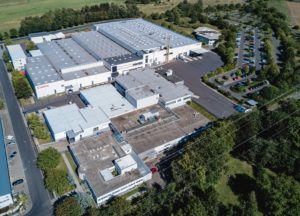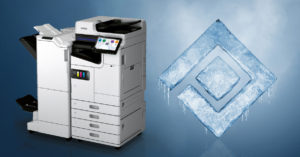Remanufacturing is a key contributor to the circular economy. It prolongs the life and value of a product by recovering and reusing materials from retired products. While circular practices such as recycling programmes (hardware and consumables) and the use of post-consumer recycled (PCR) material are well established in the print industry, the remanufacturing of products is less widely adopted. With sustainability climbing the agenda, and supply chain disruption ongoing, should print manufacturers advance their remanufacturing strategies?
Print and imaging devices have various environmental impacts during manufacture, use, and disposal. These include raw material consumption; polluting in manufacturing; energy consumption in use; and waste generated during end-of-life disposal. However, through a mix of proactivity and response to regulations such as the WEEE Directive, the print industry has worked to embed sustainability principles. For companies at the vanguard of these efforts, this is paying dividends, as buyers become more scrupulous about the lifecycle impacts of the products they purchase.
Circularity in the print industry
A circular economy is an alternative to the traditional linear economy model of ‘take-make-dispose’. Circular practices reduce resource and energy use by extending the lifetime of products, components and materials. This keeps resources in use for as long as possible, extracting maximum value from them whilst in use, and then recovering or regenerating products and materials from them at the end of life.
Circularity is already well established in the print industry. Products are often designed to reduce environmental impact across their product lifecycle. Key elements include energy efficiency, reliability, repairability and recyclability. Recycling programmes for both hardware and consumables are widespread and in some cases recycling services enable print manufacturers to incorporate components and materials into new products.
Print manufacturers are also increasing the use of recovered materials, such as recycled and recyclable content into new products. For instance, according to HP’s Sustainable Impact 2021 report, HP’s goal is to use 30% post consumer recycled (PCR) content plastic across HP’s personal systems and print product portfolio by 2025. Meanwhile, Lexmark report that their goal is to increase the average post-consumer recycled content plastic in their printer models to 50% by 2025. In FY 21, Epson report that the company began sales of products that contain recycled materials and refurbished equipment.
Remanufacturing of printing and imaging equipment
Remanufacturing plays an important role in a circular economy concept, in terms of saving raw materials and energy. Remanufacturing is an industrial process that rebuilds products from individual components – a mix of reused or repaired components and new parts. Through disassembly, cleaning, repair and replacement of worn-out and obsolete components, a product can be returned to ‘like-new’ or ‘better-than-new’ condition and just as reliable as the original product. Remanufacturing a product begins a new lifecycle for that product. When products are designed to be remanufactured, this process can continue indefinitely.
In contrast to remanufactured products which are completely disassembled and rebuilt, refurbished products are those that have been returned, may be partially disassembled and had any faulty parts removed. Typically, remanufactured products undergo a higher level of disassembly, rebuilding and retesting than refurbished devices.
Imaging equipment such as printers and multifunction peripherals (MFPs) are particularly suitable for remanufacturing due to the high value and complexity of components at the end of their first life.
The remanufacturing ecosystem typically comprises three main categories: original equipment manufacturers (OEMs), contracted remanufacturers that perform remanufacturing on behalf of OEMs, and independent remanufacturers that compete with OEMs (such as the print cartridge sector).
The benefits of remanufactured products
Remanufactured products offer several advantages:
- High standards of performance. Remanufacturers often upgrade products from old to current performance standards of energy efficiency or productivity. As such, from a customer viewpoint there is no compromise on quality or performance.
- Lower cost. Remanufactured products cost less than a new product due to the savings made from the recovery of the materials and energy content of the product.
- Shorter lead times. A remanufactured product may have reduced lead times, which minimises disruption such as supply chain issues. This can also enable manufacturers to maintain a full portfolio during global problems such as shortages in chip production.
- Lower environmental burden. By limiting the amount of raw material extracted and recycled, as well as new components produced, remanufacturing typically uses less energy than creating a new product.
- Reduction of material sent to landfill. Not all end-of-life products and/or their components are suitable for recycling; many instead end up in landfill. Remanufacturing helps keep these materials in the production cycle.
- Job creation. Because remanufacturing requires products to be disassembled as well as assembled, it increases the labour requirement. In the UK alone, the Green Alliance estimates that 3,000 UK jobs could be created in remanufacturing by 2035.
Barriers to remanufacturing
There are a number of barriers to adoption of remanufacturing. For a remanufacturer, this includes lack of consistent definitions, legislation, regulatory and trade barriers that limit the movement of materials at a product’s end of life, reverse logistics costs, and skills shortages.
From a customer perspective, currently the terminology used to describe remanufacturing is inconsistent and poorly understood. As well as low awareness, the term is often associated with inferior quality, which is far from the case given that there is no compromise on quality or performance. Educating consumers on how the quality of remanufactured equipment is equal to that of new equipment will be key to overcoming reticence around buying remanufactured products.
Print buyer considerations
Buyers must carry out sufficient due diligence when evaluating remanufactured products. For example, are warranties guaranteed, does the supplier carry enough spares to meet any needs, and is speed of maintenance guaranteed should a device fail? Also, will such devices from a third party be included in any existing MPS contract and, if not, what does that mean to an organisation’s overall print monitoring and management policy? Alternative approaches include buying from suppliers that specifically refurbish devices.
Remanufacturing and refurbishing will not fit in everywhere. For example, a new high-end device that can only be built using new chips and subassemblies will need new components throughout. However, for organisations looking to refresh devices across a larger fleet, remanufactured and refurbished devices can provide new life with full warranties at a suitable cost.
Print industry examples
Examples of remanufactured product lines include:
- Canon. Canon has undertaken remanufacturing of used multifunction devices since 1992. Canon’s ImageRUNNER ADVANCE EQ80 range comprises 80% reused materials, which reduces CO2 emissions by the same percentage compared to new devices. All Canon’s ImageRUNNER ADVANCE EQ80 models are sold with a full warranty and performance guarantee.
- Ricoh. Ricoh’s GreenLine was the first series of remanufactured MFPs to receive Energy Star certification. Ricoh’s remanufacturing process is BSi 8887-220 certified and it reports that more than 80% of existing parts and components by weight of the original device are reused or recycled. Ricoh’s remanufacturing process follows strict ISO 9001:2008 requirements with devices being certified, tested and updated with the latest software and firmware versions before they are made available with a like-new appearance. They are offered back to the market at a significantly lower price than new models, and receive the same level of after-sales support as new devices.
- Lexmark. Lexmark joined the European Remanufacturing Council (CER) as a founding member in 2017. Lexmark Evergreen is a hardware remanufacturing program allows return of certain devices to Lexmark for remanufacturing and replacement in select markets.
- Xerox. Xerox launched launched three new remanufactured models in 2021, under the new Xerox factory-Produced Program, that are certified to ENERGY STAR 3.1. Xerox’s Factory Produced New is a Xerox classification for equipment containing parts from a device that was previously in a customer location that has since been restored to meet Xerox Product Specifications. According to Xerox’s 2022 CSR report, product families are designed with a high level of commonality to maximise reuse. This allows Xerox to remanufacture parts to “like new” performance specifications while reusing 70–90% of the machine components by weight. In 2021, Xerox reports that it remanufactured approximately 10,740 office devices.
Conclusion
Remanufacturing offers clear benefits to both manufacturers and buyers. While recycling programmes and cartridge remanufacturing is already well established in the print industry, remanufactured product portfolios are not widely offered.
However, remanufactured products are just one consideration when looking to reduce the environmental impact of an organisations print infrastructure. For both remanufactured and new products, buyers must consider energy efficiency, consumables usage, end of life management along with software and services that manage and monitor the printing and imaging environment.
Ultimately, a successful remanufacturing strategy requires considerable investment and planning to ensure products are designed with remanufacturing in mind. It also requires building trust with customers regarding the quality and performance of products. By making remanufacturing a strategic priority, OEMs can extend product lifecycles, unlock new revenue streams, better serve customers and contribute more effectively to the circular economy.
Learn more about sustainability trends in the print industry, and profiles of the major OEMs in Quocirca’s Sustainability Leaders Report.
Sources used: https://www.zerowastescotland.org.uk/circular-economy/remanufacturing





